|
Me Sahyadri |
|
May 2014 |
|
Volume 1, number 2 |
|
Please use minimum 1280 pixel horizontal screen
resolution for viewing. Please be patient while all the images in
webpage are loaded. |
|
Please do not use the images for any commercial
use without permission. Text in Marathi and English is not exact
translation. Special thanks to all those who helped me during the compilation and field work for the help and guidance |
|
|
|
|
देशाची आर्थिक प्रगती व्हावी असे सर्व नागरिकांना वाटणे सहाजिक आहे. अर्थकारणामुळे मिळणारा रोजगार, समृद्धी यासाठी सर्वांनाच आर्थिक प्रगती हवी हवीशी वाटते. आर्थिक प्रगती होताना, त्याचा दिर्घकाळात समाजावर, निसर्गावर, वातावरणावर दुष्परिणाम होणार नाही याची काळजी घेणे महत्वाचे आहे. मनुष्याच्या भावी पिढ्यांना पाणी, शुद्ध हवा, योग्य वातावरण मिळत रहावे अशी भावना मनात रुजणे महत्वाचे आहे. वाढत्या आर्थिक प्रगतीमुळे नैसर्गिक संपदेवर ताण येतो. प्रगतीसाठी प्रदुषण होते. जंगले, माळराने, व इतर अधिवास नष्ट होतात. वसुंधरेवर रहाणाऱ्या इतर जीवांचा मात्र मनुष्य फारसा विचार करत नाही. आर्थिक प्रगती करताना, मनुष्य निसर्गाची हानी करत आहे. मुळताच माणसाला निसर्गाचे महत्व समजणे हे सध्याच्या आपल्या प्रगत जीवनशैली मुळे अवघड झाले आहे. आर्थिक प्रगती, समाजाची प्रगती व निसर्ग संपदेची निगा, यांचा समतोल राखणे काळाची गरज आहे.
सह्याद्री (पश्चिम घाट) हा एक नैसर्गिक संपदेचा, वैविध्यतेचा, भौगोलिक व ऐतिहासिक ठेवा आहे. वाढत्या मानवी अतिक्रमणाचा, सह्याद्रीच्या विविध घटकांवर होणारा दुष्परिणाम भविष्यात आपल्यालाच धोका निर्माण करेल, यात शंका नाही. शुद्ध पाणी, हवा व उर्जा, भावी पिढीला मिळण्यासाठी, नंद्यांचे उगम असलेला सह्याद्री व त्याभागातील जंगले टिकवणे महत्वाचे आहे. सह्याद्रीच्या महत्वाच्या घटकांचे महत्व छायाचित्रांद्वारे प्रकट करण्याचा मी येथे प्रयत्न केला आहे. येथील पक्षी, प्राणी, वनस्पती, अधिवास, किल्ले व लेणी अशा विविध विषयांबद्दल आपण समजुन घेऊ.
|
|
As the economic development has taken the center stage, the balance between the environmental sustenance and socio economic development will be under the scanner. As most experts with balanced views have proclaimed, Indian wildlife and ecological system sustenance will be under threat, unless precautions are taken with the help of appropriate research and long term national interests. As we encounter the economic development, many habitats which indirectly or directly help sustainable development will be damaged. The awareness to gauge the success by sustainable development and not by year to year growth is a distant dream any environmentalist will assume in current scenario.
Western ghats, or Sahyadri as we all call it as, is a treasure trove of spectacular landscapes, biodiversity, flora, fauna, some amazing geological wonders and man made monuments. With the increasing pressure from human encroachment, all these elements are under stress and in turn are under depletion. Western ghats should be left untouched by human beings, to protect their future generations from getting short of resources, such as water, energy and clean air. The important elements of western ghats, which need protection are highlighted in the new version of Photo journal, Me Sahyadri Magazine.
|
|
|
| |
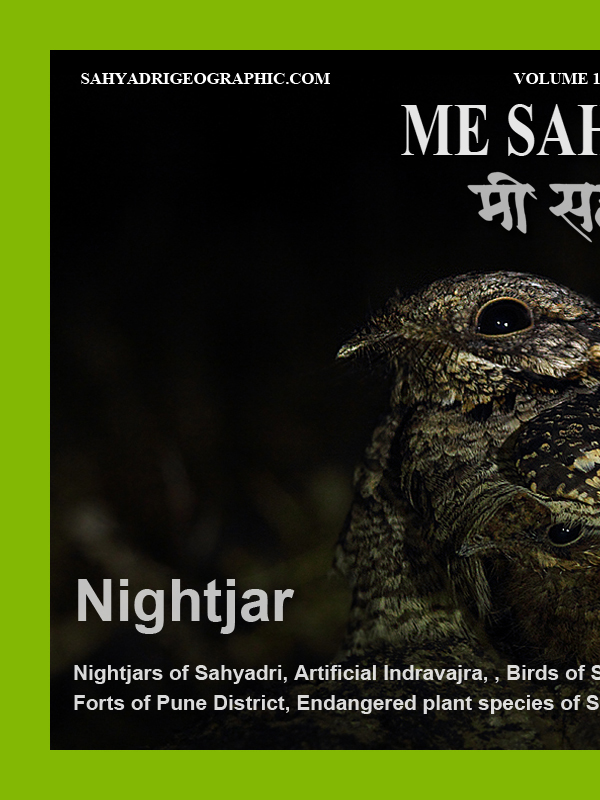 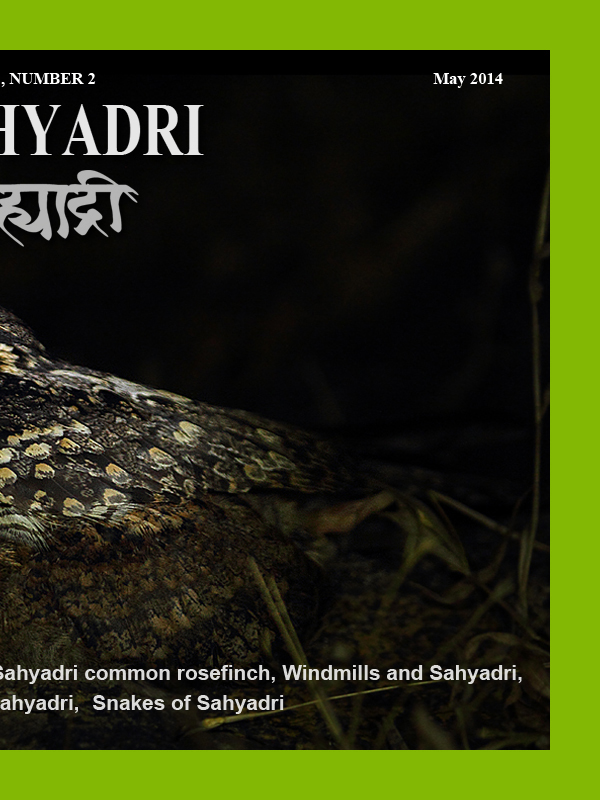 |
| |
| Me Sahyadri – May 2014
|
| |
|
|
या सदरात, सह्याद्रीच्या विविध घटकांबद्दल छायाचित्र व माहिती द्वारे तोंड ओळख मांडली आहे.
|
|
This journal introduces various elements of Sahyadri through brief information and photographs.
|
|
|
| |
  |
| The banner has been published here to improve the awareness of the trekkers and tourists visiting the various mountain forts, mountains in north western ghats. Please avoid accidents, by following good outdoor ethics such as no swimming in cisterns at mountain forts, no rock climbing without proper technical equipment and expertise. Please do not adventure, trek with any group or individually without understanding the risks associated. The frequency of the solo trekker fatalities have increased recently. Please strictly avoid solo treks. Please also avoid treks to mountains in large commercial groups, as it leads to damage to biodiversity of these high elevation ecological islands. Please respect the wildlife and biodiversity of the region. This has become more important as the ever increasing human interference is leading to severe damage to fragile ecosystems. Please be aware of the wildlife and biodiversity of the mountains before visiting these mountains. Please follow outdoor ethics. Follow ASI and Forest department rules. The concept of use of symbols for outdoor ethics was conceived and designed by "Sahyadri Trekker Bloggers Group". |
| |
|
|
| |
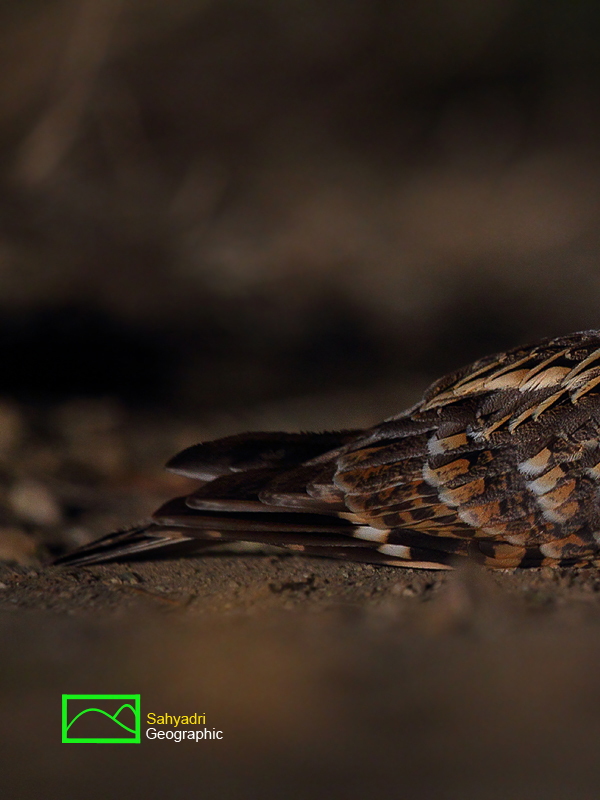 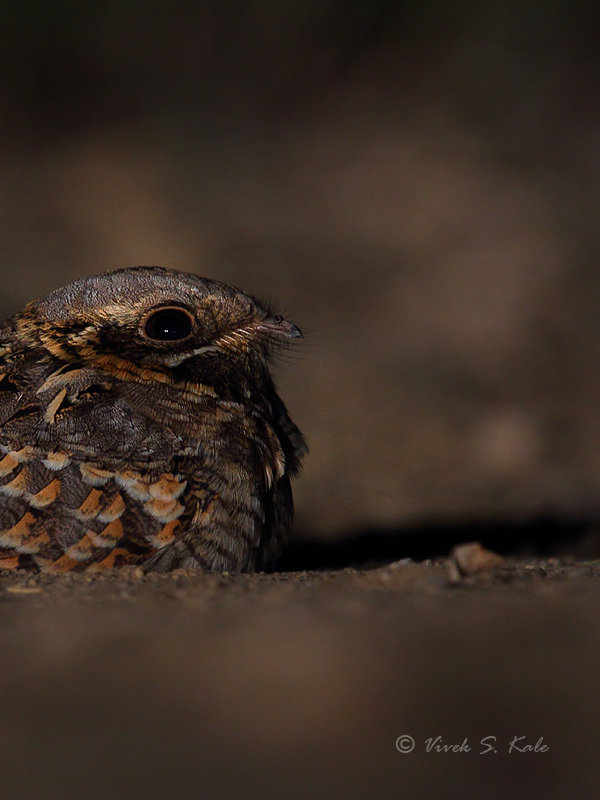 |
| |
| Indian Nightjar, Western ghats, India
|
| |
|
|
रातवा एक निशाचर पक्षी आहे. रात्री हा पक्षी सक्रिय असतो. रातवा दिवसा आराम करतो. रातवा छोटे पतंग, किडे खातो. त्याच्या अंगावर ठिपके व रेघांचे अदभुत डिझाइन असते. त्यामुळे तो जमिनिवर बसलेला असताना किंवा झाडावर बसला असताना पटकन ओळखु येत नाही. त्याचे रंगरुप झाडाच्या सालीत व पालापाचोळ्यात लपते. यामुळे या पक्ष्यांना, दिवसा आराम करणे सोपे होते. रात्री हे पक्षी बऱ्याचदा जमिनीवर बसलेले दिसतात. आपल्या पृथ्वीवर रातव्यांच्या ८० जाती आहेत. त्यांचे रहाणीमान एक्सारखे असले तरी, रंगरुप, आकार, अधिवास यात फरक आहे. भारतात ९ जातीचे रातवे आढळतात. त्यात प्रामुख्याने भारतीय रातवा, करडा जंगल रातवा, सव्हाना रातवा, जेर्डॉन रातवा, इजिप्शियन रातवा, युरेशियन रातवा, मोठया कानांचा रातवा, साइक्स रातवा, मोठया शेपटाचा रातवा असे प्रकार आहेत. या ९ जातींपैकी ५ जातींचे रातवे सह्याद्री परिसरात आढळतात. (भारतीय रातवा, जंगल करडा रातवा, जेर्डॉन रातवा, सव्हाना रातवा व मोठया कानांचा रातवा). यातले कोणतेच रातवे जरी सह्याद्रीचे अंतर्जन्य नसले तरी त्यांचा पर्यावरणाच्या सृष्टीशृंखलेत महत्वाचे स्थान आहे. भारतीय रातवा आकारने लहान असतो, त्याच्या पखांवर तपकिरी ठिपके असतात. मोकळ्या माळावर व डोंगरांच्या पायथ्याला तो आढळतो. रातव्याच्या रात्री च्या संचारामुळे घुबडांसारख्याच त्यांच्या बाबतीत बऱ्याच गैरसमजुती व अंधश्रद्धा आहेत.
|
|
Nightjars are the nocturnal birds. They are active in the night and take rest in the day time. These birds feed on moths and insects in the night or during early morning. They are very well camouflaged. The camouflage is like dried leaves or tree bark. This helps these birds to remain undetected during the day time when these birds take rest. These birds are seen roosting on the rocks or on the ground during night. There are about 80 species of nightjars on our planet. They vary in their shape, size, plumage and habitat. There are nine species of nightjars seen in India. These include, Indian nightjar, Large-tailed nightjar, Grey nightjar, Syke’s nightjar, Savana nightjar, Jerdon’s nightjar, Great eared nightjar, Eurasian nightjar, Egyptian nightjar. Out of these nine species, about 5 species, namely Indian nightjar, Savana nightjar, Grey nightjar, Jerdon’s nightjar, Great eared nightjar are seen in western ghats. Though none of these birds are endemic, they play a vital nocturnal role in the forest clearings and open country habitats in western ghats.
Indian nightjar (Caprimulgus asiaticus) is a widespread resident nightjar, It is a small but brightly streaked and dotted with brown patterns. It is seen in open country and at the foothills. Nightjars are often heard in the night than they are seen. Due to nocturnal nature of these birds many superstitions are associated with the bird all across the world.
|
|
|
| |
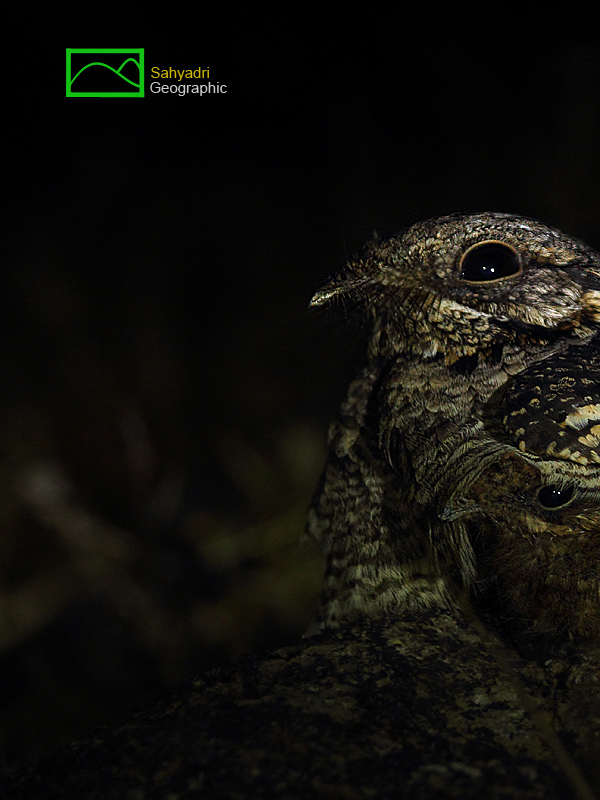 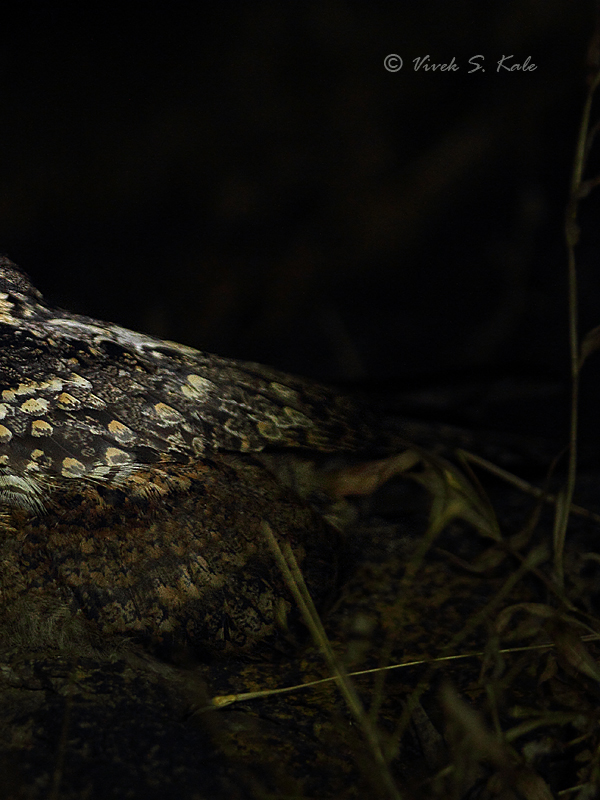 |
| |
| Grey nightjar female with juvenile, Chandoli national park, Western ghats, India
|
| |
|
|
करडा जंगल रातवा आकारने मोठा असतो. त्याच्या करड़्या रंगरुपावर काळे, तपकिरी ठिपके असतात. कापु कापु कापु असे तो ओरडतो. शहरातल्या झगमटामुळे रातव्यांना अंधारकडे पळ काढावा लागला आहे. हे पक्षी जमिनिवरच अंडी टाकतात.
|
|
Grey nightjar or Indian jungle nightjar (Caprimulgus indicus) is widespread resident bird. It is grey in color with light brown and heavy black markings. Its song is loud with Chuk-chuk-chuk-chuk call. It is about 28 to 32 cm in size. These birds do not build the nest. They lay the eggs on the ground.
|
|
|
| |
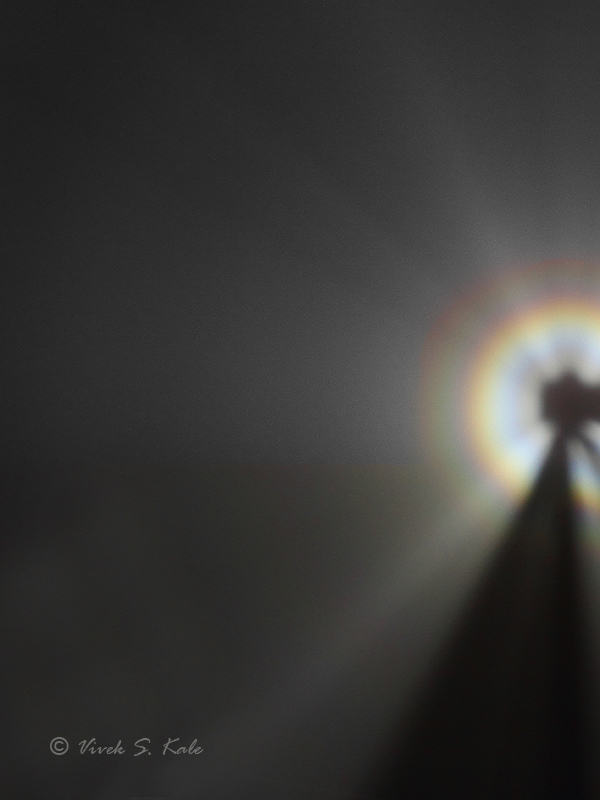  |
| |
| Artificial Indravajra, Ratangad, Western ghats, India
|
| |
|
|
आभाळात दिसणारे इंद्रधनुष्य न पाहिलेला माणुस शोधुन सुद्धा सापडणार नाही. इंद्रधनुष्याच्या रंगात असणारी किमया सर्वांच्या मनात आनंदाचा तरंग फुलवते. पावसाळ्यात आपल्या एका बाजुला सुर्य व दुसऱ्या बाजुस पाउस अशी स्थिती झाल्यास क्वचित इंद्रधनुष्य दिसते. इंद्रधनुष्य हे पाण्याच्या लहान थेंबात होणाऱ्या प्रकाशाच्या परावर्तन व वक्रिभवन यामुळे दिसते. सफेद रंग या प्रक्रियेत ७ रंगात विभागला जातो. त्यांच्या तरंग लांबीतल्या फरकामुळे आपल्याला लाल ते जांभळा असे रंगाचे पट्टे दिसतात. इंद्रधनुष्या सारखीच पण दिसण्यास वेगळी अशी अजुन एक किमया आहे ज्याचे नाव आहे इंद्रवज्र. इंद्रवज्र संपुर्ण गोल दिसते. त्यात ३ किंवा अधिक रंगीत पट्ट्यांचे संच दिसतात. आकाराने लहान असले तरी ते पाहिल्यावर पाहणारा अचंभित होतो. उंच पहाडावर विशिष्ठ परिस्थिती जुळुन आल्यास इंद्रवज्र दिसते. देवाच्या डोक्याभोवती कल्पित प्रभाचक्रा प्रमाणे ते भासते. इंद्रवज्रात फक्त रंगच दिसत नाहीत. त्यात आपल्याला आपली सावली मध्यभागी दिसते. आपल्या सावली भोवती दिसणाऱ्या या प्रभे मुळे आपण देवासमान असल्याचा पाहणाऱ्यास आभास होतो. देव दुसरा कोणी नसुन आपल्यातील चांगल्या प्रवृत्तींचा सारांश आहे असे मन समजते. शास्त्रीय दृष्टिकोन असणाऱ्यास इंद्रवज्र एक गमतीदार पण गहन कोडे वाटते.
पुढच्या पावसाळ्यात रतनगडावर मोहिमे दरम्यान पुन्हा धुक्याने वेढले. धुके एवढे दाट होते, की श्वास घेणे अवघड जात होते. गुहेतल्या आतल्या भागात जेमेतेम कोरड़्या भागात रात्रभर श्वास घेतला. बाहेरच्या धुक्यात, रात्री चक्क इंद्रवज्र उमलले.
|
|
.The expedition to see and photograph the circular rainbow (Indravajra) in Western Ghats took us to Konkan cliff of Harishchandragad. Being one of the geological wonders of Western Ghats, the cliff has amazing structure. It is a vertical precipice with overhang. The overhang is about 10 meters. The height is 3900 feet (1300 meters) above msl. There is a semicircular valley on the western end of the mountain having vertical fall depth of 1200 feet. The horizontal arc length of the cliff top edge is about 1 km. In the pre and post monsoon season, a strange natural phenomenon called as glory or circular rainbow can be seen from this cliff edge. The phenomenon is similar to rainbow. However its scientific principle and structure is entirely different from that of rainbow. The normal rainbow is called as “Indradhanushya” in Marathi. The glory or circular rainbow is called as “Indravajra” in Marathi. In western world the spectacle is named the “spectre of the Brocken” after the peak in the Harz Mountains of Germany, where it is often seen. The optical illusion is purely a natural phenonmenon. In another expedition we were caught on another fort in the region called Ratangad. The weather was unbreathable. The heavy moisture present on the top made survival difficult. Thanks to a cave where we could find the small section with dry air, that we could breadth whole night. The fog was intense and triggered us to conduct the experiment to create the indravajra artificially.
|
|
|
| |
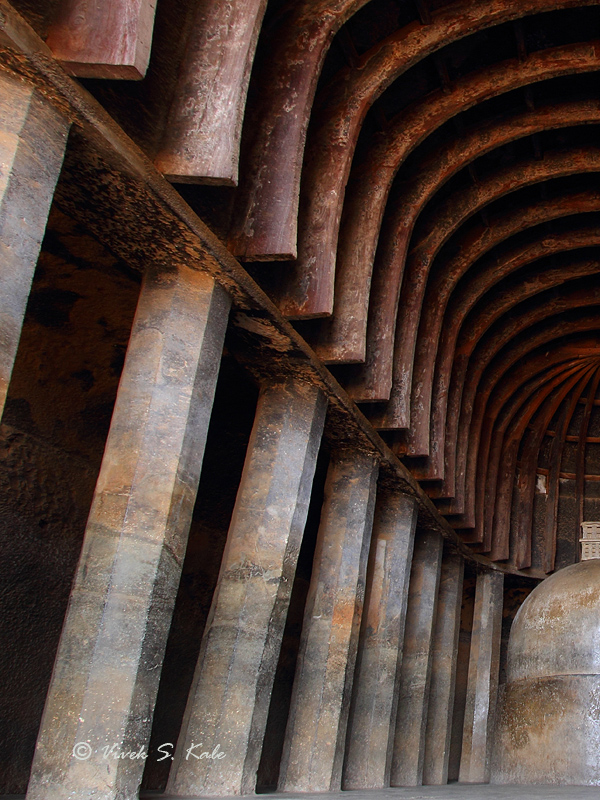 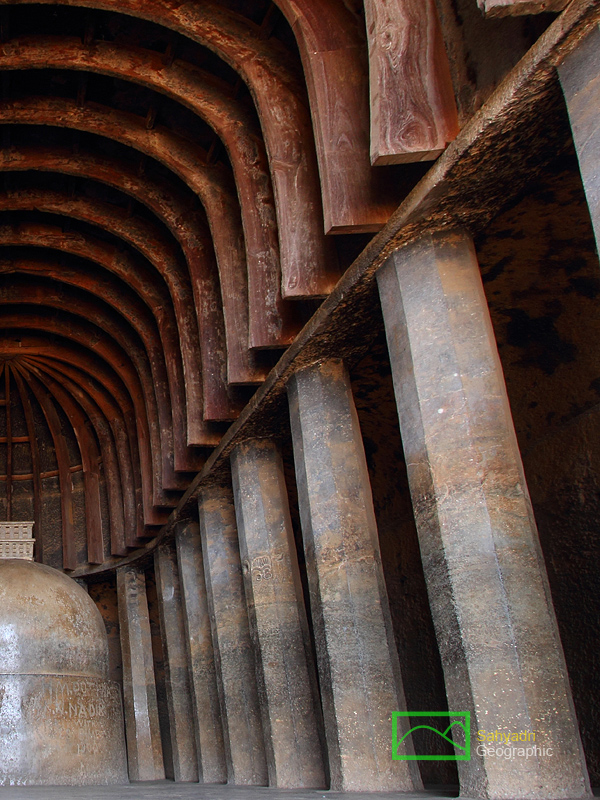 |
| |
| Bhaje Caves, western ghats, Pune district, Maharashtra, India
|
| |
|
|
भाजे लेणी पुण्याच्या पश्चिमेस मावळ प्रांतात आहेत. अंदाजे २००० वर्षांपुर्वी कोरलेली भाजे चे लेणी हा भारतीय स्थापत्यकलेचा एक अनोखा धागा मानला जातो. सम्राट अशोकाच्या नंतर, हिनायन काळात लेणी कोरली आहेत. येथील चैत्यगृह २६ फुट रुंद व ५९ फुट लांब आहे. स्तुपाचा व्यास ११ फुट आहे. स्तुपावरचे शिखर दगडी असुन ते मुळ स्तुपावर चढवले आहे. येथे २७ अष्ट्कोनी खांब आहेत. या खांबांवर पुर्वी सुंदर चित्रे रंगवली होती. आज आपणास खांबांवर असलेली काही कोरलेली चिन्ह पहावयास मिळतात. त्रिशुळ, कमळ. धर्मचक्र इत्यादी चिन्हे आहेत. छत घुमटाकार असुन त्याला आतुन लाकडी फासळ्या लावल्या आहेत. काही फासळ्या पुरातन असुन त्यावर त्याकाळातले संदर्भ लिहिलेले आहेत. लेण्याचा पुढचा भाग पुर्वी लाकडाच्या भिंतीने झाकलेला असावा. लेण्याच्या योग्य जागेमुळे याच काळात कोरलेल्या इतर लेण्यांपेक्षा भाजे लेणी चांगल्या स्थितीत आहेत. पश्चिमेला तोंड असलेली लेणी समोर आडोसा असलेल्या डोंगरामुळे पाउस वाऱ्यामुळे थोडी बचावली आहेत.
|
|
Bhaje caves were excavated 200 B.C. The chaitya Griha of Bhaje is a unique masterpiece. The hall is 26 feet wide, 59 feet long. There are 27 octagonal columns. The stupa is 11 feet in diameter. The Stupa has a capital at the top which is a separate piece, unlike at Bedse. There are symbols carved in the columns. These include the trisula, flowers etc. The roof is arched and has wooden girders. Most of the wooden girders are ancient and has script written on it. The caves were having lot of wooden work in the ancient times. The good rock and good location of the caves helped it to survive over 2000 years in good condition.
|
|
|
| |
 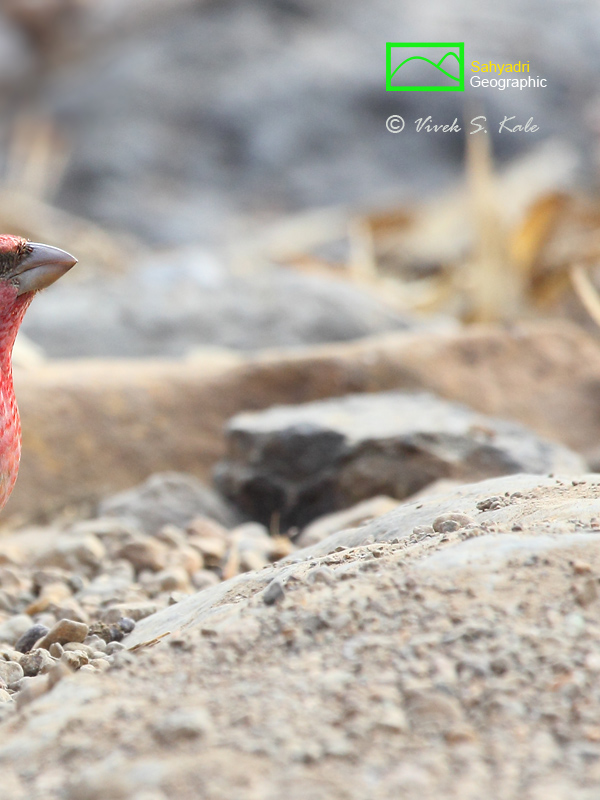 |
| |
| Common Rosefinch male, Western ghats, Raigad district, Maharashtra, India
|
| |
|
|
रोज फिंच (गुलाबी चिमणी) हा पक्षी उत्तरेकडुन हिवाळ्यात आपल्याकडे स्थलांतर करुन येतो. मार्च एप्रिल पर्यंत तो आपल्याकडे दिसतो. सुंदर गुलाबी नर, व हिरवट छटा असलेली मादी असे त्यांचे बाह्यरुप असते. गवताच्या बीया खाण्यासाठी त्यांच्या चोची अनुरुप असतात. बियांचे आवरण काढुन त्या तोडण्याचे काम शिताफीने आपल्या चोचीने करतात. अशा या गवताच्या बिया खाउन जगणाऱ्या पक्ष्यांसाठी गवत अत्यंत महत्वाचे असते.
|
|
Common Rosefinch (Caropdacus erythrinus) is a small bird (14-15 cm) which migrates from, Himalaya to main Indian subcontinent in winter. The male adult bird is plain faced with deep red head, breast and rump. It supperparts are red washed extending to lower belly. These birds feed on grass seeds, nectar, berries and small flowers etc. The female is not red colored. Female is light green with streaks on its upperparts.
|
|
|
| |
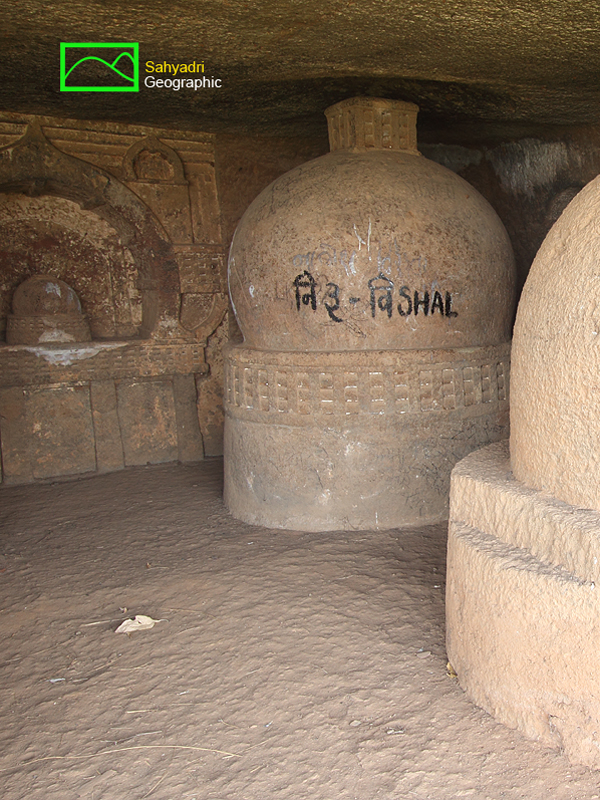 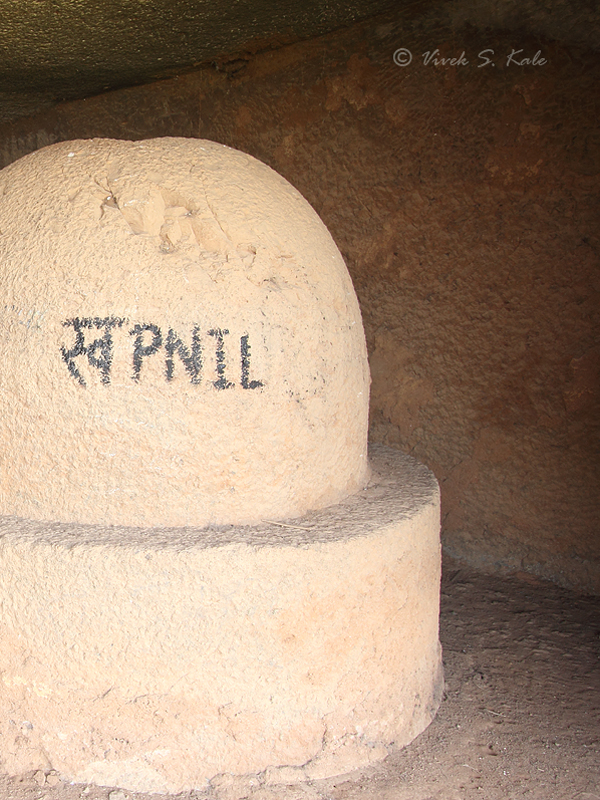 |
| |
| Graffiti done by local village youngsters, Thanale caves, Western ghats, Raigad district, Maharashtra,India |
| |
|
|
कोकणातले स्थानिक युवक येथे येतात. आपली नावे भिंतींवर, येथल्या स्तुपांवर रंगवतात.
असे हे विद्रुपीकरण, सरकार चे दुर्लक्ष्य पाहुन फार वाईट वाटते.
ऐतिहासिक स्मारकांवर रंगकाम करण्यामागे काय प्रवृत्ती असते ?
१) मुळातच शाळेत व घरात झालेले संस्कार याला कारणीभुत असावेत.
२) मनातला न्युनगंड कमी करण्यासाठी आपली नावे लिहिली जातात.
३) आपल्या मनातील कल्पकता दाखवण्यासाठी, तरुण मुले असे करत असावीत.
छायाचित्रात दिसत असल्याप्रमाणे, देवनागरी व इंग्रजी लिपीचा संमिश्र वापर करुन नावे महत्वाच्या स्तुपांवर लिहिलेली दिसतात. खास म्हणजे लिहिणारे ब्रश, रंग आपल्या खिशातुन पैसे खर्च करुन आणतात.
४) मुळातच लेण्यांबद्दल अजिबात माहिती नसल्याने असे होते. सर्व लेण्यांच्या जागी जर त्याचे महत्व सांगणारे शिलालेख लावले तर असे विद्रुपिकरण कमी होईल.
|
|
Thanale caves are Buddhist caves carved out 200 years B.C. The caves have many significant carvings of symbols and stupas. Such significant caves are defaced by miscreants. The graffiti is seen made on important Stupas.
1) Lack of specific primary instructions in education system,
2) Lack of knowledge or access to information about the significance of caves,
3) Desire to show the artistic intent,
4) To overcome the inferiority complex,
5) For personal or local organization’s propaganda medium.
These and many more probable reasons are behind such graffiti. If ASI puts the significance literature in the form of stone-script, it may reduce such graffiti.
|
|
|
| |
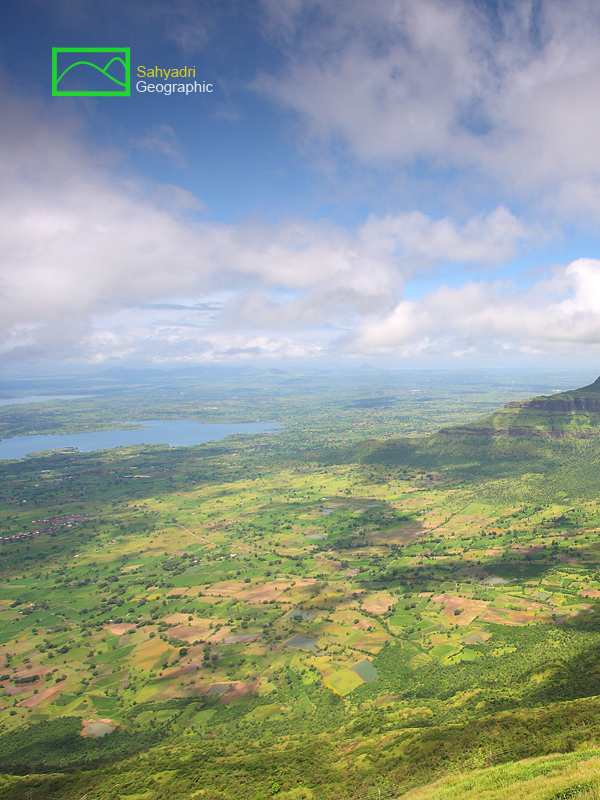 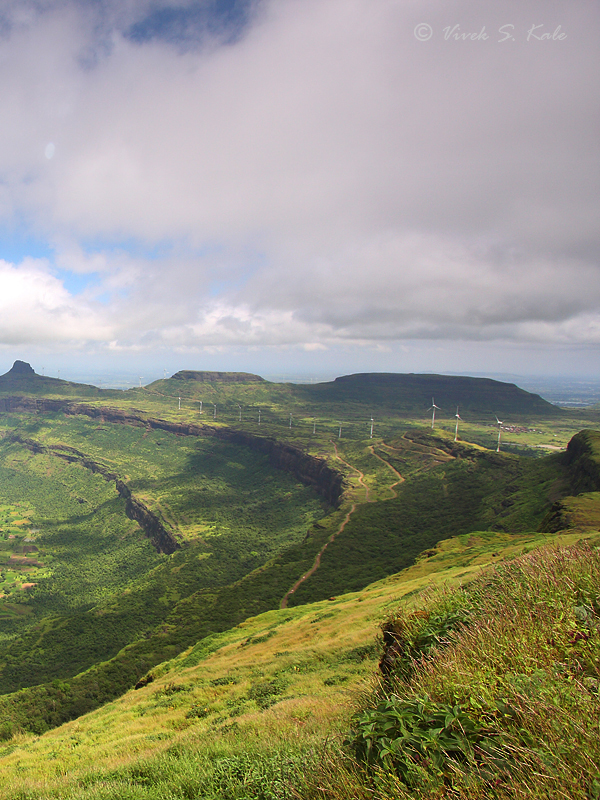 |
| |
| Windmills on Patta fort, Nasik District, Western ghats, Maharashtra, India
|
| |
|
|
उर्जा. भारताच्या वाढत्या लोकसंख्येमुळे व विकसनशील अर्थव्यवस्थेमुळे, उर्जेची मागणी वाढत आहे. निर्मितीचा खर्च, व प्रदुषण यामुळे उर्जेचे अपारंपारिक स्त्रोत शोधले व वापरले जात आहेत. भारताची उर्जा निर्मिती अंदाजे २२० गिगा वॅट आहे. त्यातला ८.५ % वाटा पवन उर्जेचा आहे (अंदाजे १९ गिगा वॅट). पवन उर्जा वरकरणी प्रदुषण न करणारी भासली तरी पवन उर्जा निर्मिती करताना योग्य निकष न पाळल्यामुळे, त्याचा परिणाम वन्यजीव व पक्ष्यांवर होतो असे आढळुन आले आहे. भारतात पवन उर्जेची उपलब्धी सर्वात जास्त असलेली काही ठिकाण आहेत.(२०० वॅट/मीटर वर्गपेक्षा जास्त).
या ठिकाणांमध्ये अर्धा भाग सह्याद्रीच्या घाटमाथ्यवर आहे. नैसर्गिक दृष्ट्या महत्वाच्या ठिकाणांवर ज्याला आपण संवेदनशील असे म्हणतो, अशा भागात पवन उर्जा जास्त उपलब्ध आहे. सहाजिकच आपली उर्जेची तहान भागवताना, आपण पवन चक्क्या उभ्या करताना, जंगले तोडत आहोत. नाजुक पशु पक्ष्यांवर त्याचा विपरित परिणाम होतो. रस्ते बनविले जातात. बांधकाम करताना बरिच हानी होते. कास च्या पठाराजवळ पवनचक्या बांधल्या आहेत. तसेच बऱ्याच महत्वाच्या ठिकाणी पुर्ण अभ्यास न करताच पवन चक्या उभारताना जंगलतोड होताना दिसत आहे. छायाचित्रात पटटा किल्ला दाखविलेला आहे. किल्ल्याच्या चहुबाजुने पवनचक्क्या दिसतात. रस्त्यांचे जाळे विणले आहे. ते करताना मुळ अधिवासाला धक्का पोहोचतो.
|
|
India is a developing country. Due to her rising need of power, the newer non conventional energy sources are being tapped. One of the leading non conventional energy source is wind energy. India generates about 220 GW electricity. Out of 220 GW, about 8.5 % i.e. 19 GW electricity is generated by wind energy. Though it is 8.5 % by capacity, actual contribution is less as wind is not available all the time. Though on face of it, wind energy is clean energy, it has some side effects on Nature which are grave. Most of the high wind regions of India are also the ecosensitive. Roughly about 40 % of high wind region of India falls in western ghats upper plateau ridge. Wind mills have been built in large numbers in very ecosensitive region. The construction of wind mills require building of roads and other infrastructure. The deforestation and human interference leads to damage to the wildlife, habitat, and often it leads to defacement of the landscapes. The photographs shows the ridge of Patta fort in Nasik district, which is surrounded by large number of windmills.
|
|
|
| |
 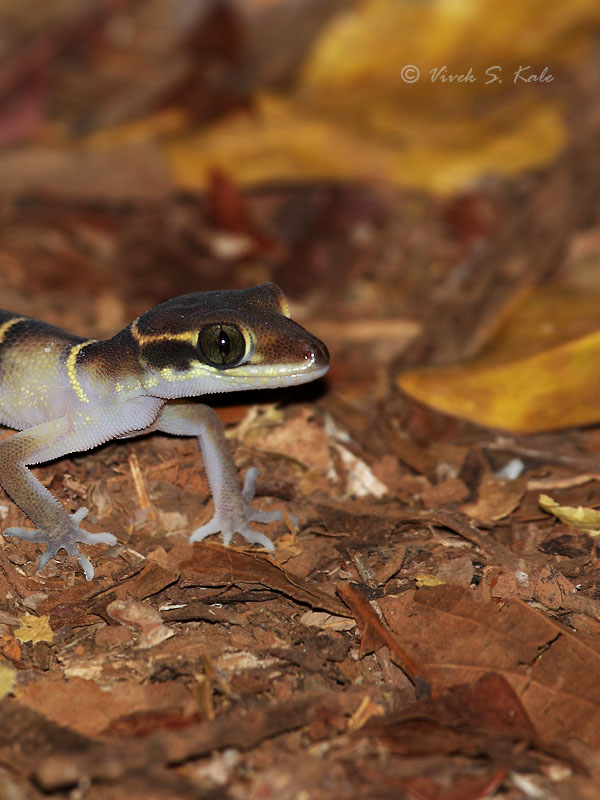 |
| |
| Gunther's Indian Gecko
(Geccoella Deccanensis), Chandoli national park, western ghats, India
|
| |
|
|
गुंथेर पाल (गेको), सह्याद्रीच्या काही भागात आढळते. हि पाल जंगलात जमिनीवर आढळते. अंगावर पट्टे असतात. हि पाल अंतर्जन्य आहे. सह्याद्रीच्या उत्तर भागात ती आढळते. जगात इतरत्र कोठेही आढळत नाही.
|
|
Gunther’s Indian Gecko is a small reptile seen in Sahyadri. It is endemic to the north western ghats. It is seen in Maharashtra and north Karnataka.
|
|
|
| |
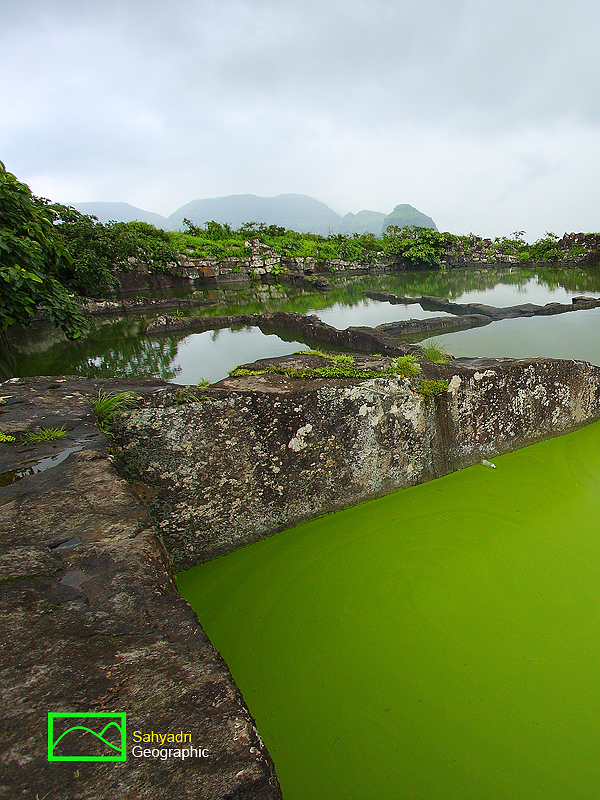 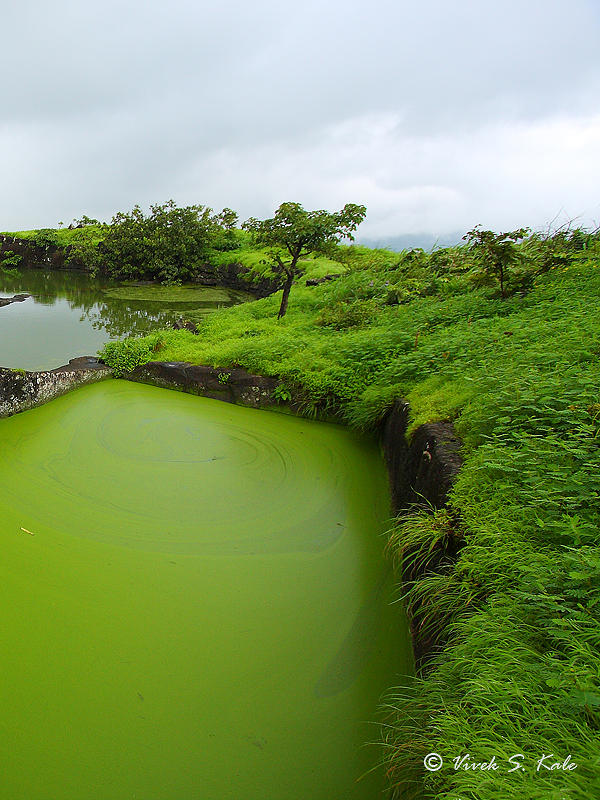 |
| |
| Saptakund, Chavand fort, Western ghats, Maharashtra, India
|
| |
|
|
आपल्या सह्याद्रीत महत्वाच्या ऐतिहासिक घडामोडी घडल्या. सतराव्या शतकात, छत्रपती शिवाजी महाराजांनी येथील दुर्गमतेचा, योग्य उपयोग केला. तसे करताना त्यांनी निसर्गाला धक्का लागु दिला नाही. त्यांनी निर्माण केलेल्या राष्ट्रप्रेमाचे स्फुरण आजसुद्धा आपल्याला त्यांच्या चरित्रातुन मिळते. अशा सह्याद्रीच्या ऐतिहासिक महत्वाची जरी बहुसंख्य नागरिकांना जाण असली तरी, त्याच्या भौगोलिक महत्वाची मात्र बहुसंख्य नागरिकांना जाण नाही. ज्या सह्याद्रीतुन अर्ध्या अधिक महाराष्ट्राला जलपुरवठा होतो, त्याचे पावित्र्य राखणे हे महत्वाचे आहे. येथील, डोंगरांचे, त्यातील स्फुरण देणाऱ्या पुरातन वास्तुंचे, इथल्या प्रत्येक दगडाचे, गवताच्या प्रत्येक पात्याचे, झाडांच्या प्रत्येक मुंळाचे, त्यांवर जगणाऱ्या प्रत्येक वनजीवाचे आपण ऋणी आहोत.
|
|
The north western ghats in state of Maharashtra, underwent lot of political and commercial upheaval during the past. It was seventeen century when a major political battles were fought between the invaders and King Shivaji in western ghats. The Sahyadri range has today some of the remains of the forts and battlefields from the past, from this era. We today enjoy the democratic freedom, which King Shivaji imagined and founded in 17th Century. Even today many get inspired by his nationalism. When we follow the history of the north western ghats, we overlook the geography, flora and fauna of the region. I have tried to generate the cross learning medium here.
|
|
|
| |
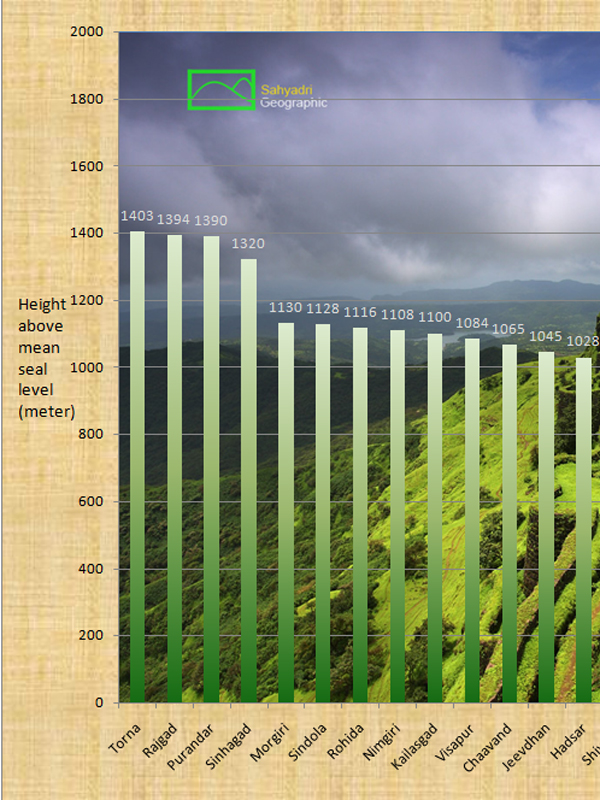 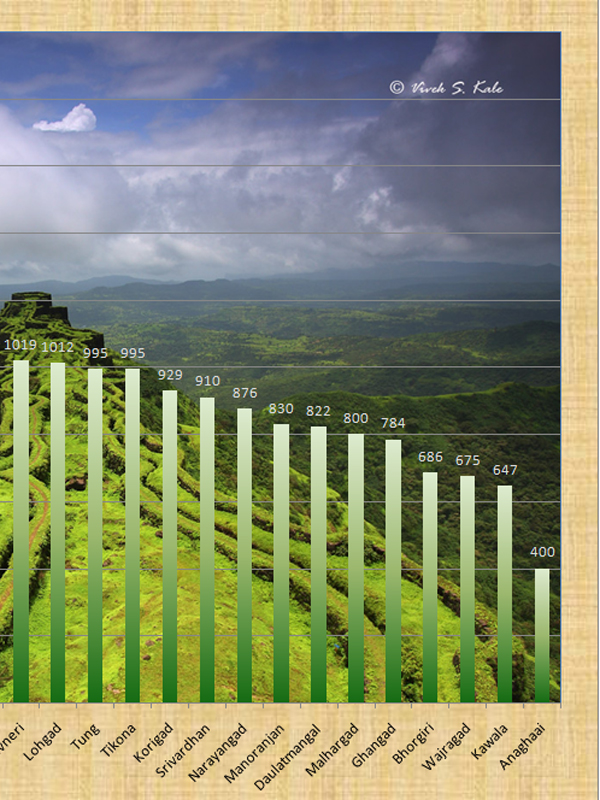 |
| |
| Altitude of mountain forts in Pune district,Western ghats, India
|
| |
|
|
पुणे जिल्ह्यात अंदाजे २८ डोंगरी किल्ले आहेत. आलेखात दाखवल्याप्रमाणे, २८ पैकी ४ किल्ले फार उंच आहेत. त्यांची उंची १३०० मीटर पेक्षा जास्त आहे. एखाद्या ठिकाणाची समुद्र्सपाटीपासुन ची उंची, हा तेथेल्या वातावरणाचा एक महत्वाचा प्रमापक आहे. उंची १२०० मीटर वर असल्यास तेथे विशिष्ठ वनस्पतीं आढळतात.
एखाद्या किल्ल्याचे संवर्धन करणे, म्हणजे तेथील सर्व जमिन साफ करणे, तेथील सर्व वनस्पती काढुन टाकणे असा एक गैरसमज सर्वत्र पसरत आहे. ऐतिहासिक ठिकाणाच्या ऐतिहासिक महत्वापेक्षा तेथील नैसर्गिक संपदेचे महत्व कित्येक पटिने जास्त आहे, हे समजुन घेणे महत्वाचे आहे. संवर्धन करणाऱ्यांनी पुर्ण माहिती शिवाय साफसफाई करणे चुकीचे आहे. पुणे जिल्ह्यातील बऱ्याच किल्यांवर अत्यंत दुर्मिळ वनस्पती (गवता पासुन मोठ्य़ा झाडांपर्यंत आहेत).
उदाहरण म्हणुन पुरंदर घेऊ यात. आज तेथे लष्करी ठाणे आहे. पुरंदराची उंची, तेथील कोरडी हवा, कमी पर्जन्यमान यामुळे तेथे काही दुर्मिळ वनस्पती आढळतात. त्यातल्या काही वनस्पती इतरत्र जवळपास फक्त हिमालयात, अफगाणिस्तानात आढळतात. पुरंदरावर आढळणारी "शिंदळ माकडी" वनस्पती अत्यंत दुर्मिळ आहे, लुप्त होण्याच्या मार्गावर आहे.
|
|
Most of the mountain forts are actually islands of high altitude land, surrounded by a sea of low altitude hills and land.
In this series I am putting forward some important geospatial parameters about the mountain forts of Pune district, with the list of botanically important species found on these forts.
In the chart, above you can see that there are about 28 mountain forts in Pune district. The altitude of these mountains vary. Also the position of these mountains with respect to the main western ghat ridge is different.
Altitude is a specific parameter. Above 1000 meter altitude the flora and fauna changes. The 4 top mountain forts, namely Sinhagad, Rajgad, Torna and Purander are amongst the top 40 high rise mountains of western ghats. These hill tops have special vegetation. Purander for example has plant species such as Frerea indica, which is endangered species. Some of the species which are seen on Purander can only be seen nearest in Himalayas and Afganistan. Purander is important botanical place not only because of its altitude but also because of the far distance of this fort from western ghats ridge as compared to other 3 forts.
|
|
|
| |
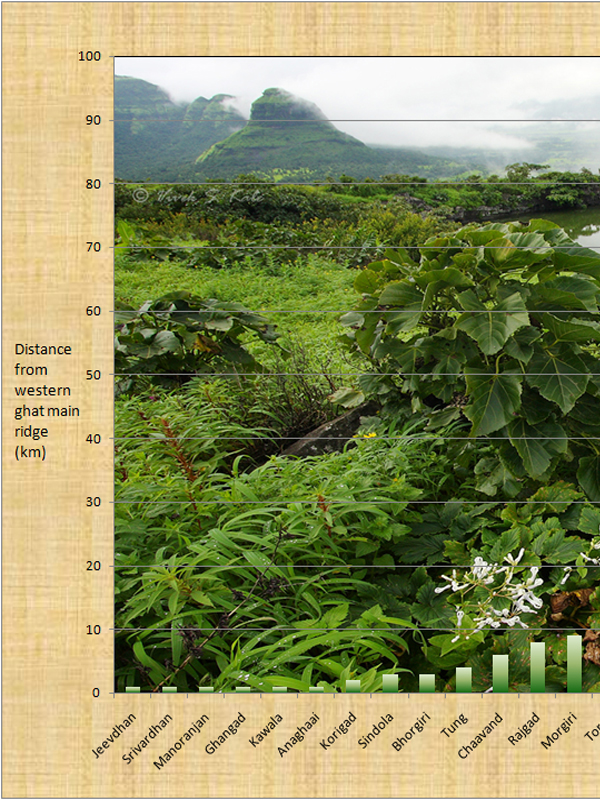 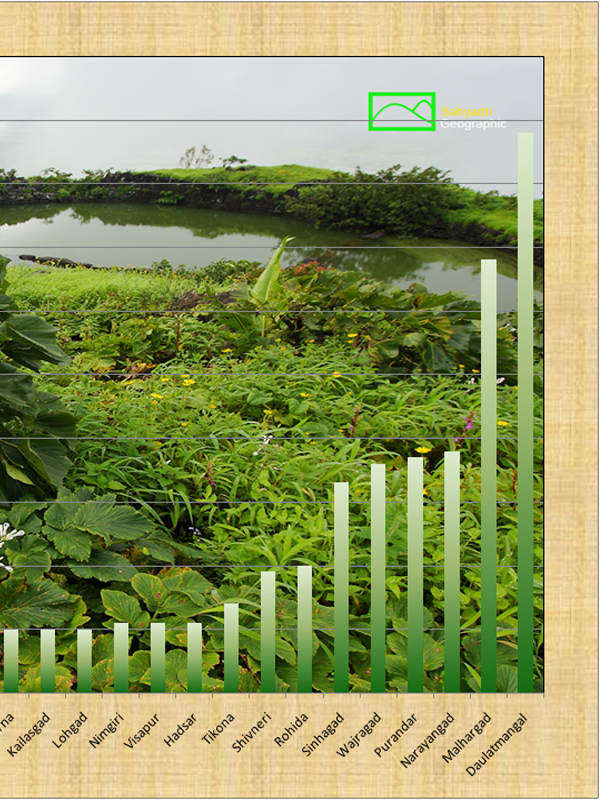 |
| |
| Distance of mountain forts from main western ghat ridge in Pune district,Western ghats, India (Flowered plant of Ceropegia rollae at Chavand fort in background picture)
|
| |
|
|
समुद्र्सपाटी पासुन असलेली एखाद्या ठिकाणची उंची जशी महत्वाची असते, त्याप्रमाणे एखाद्या ठिकाणची आद्रता व तापमान महत्वाचे असते. सह्याद्रीच्या मुख्य रांगेपासुन (घाटापासुन) दक्षिण पठारावर (देशावर) असलेल्या डोंगराचे अंतर तितकेच महत्वाचे आहे. घाटमाथ्यावर म्हणजे घाटापासुन १० कि मी च्या आत असलेली सर्व ठिकाणे, डोंगर हे विशिष्ट सृष्टी निर्माण करतात. तेथे विशिष्ट वनस्पती व किटक आढळतात. वरिल तक्त्यात दाखवल्याप्रमाणे पुणे जिल्ह्यातील बहुतेक डॊंगरी किल्ले ( २८ पैकी १९) या पट्ट्यात आढळतात. पावसाळ्यात हे डोंगर किल्ले ढग व धुक्यात लपलेले असतात. त्यांच्या माथ्यावर भरपुर आद्रता असते. एक उद्दाहरण म्हणुन आपण चावंड पाहु. पावसाळ्यात येथे गेल्यास भरपुर गवत माजलेले दिसते. प्रथमदर्शनी हे गवत माजलेले दिसत असले तरी यात काही दुर्मिळ वनस्पती आहेत. त्यातील एक आहे, रोलाई ची खरपुडी. या अत्यंत लहान फुट दोन फुट वाढणाऱ्या वनस्पती ला जपणे महत्वाचे आहे. गवत साफ करता करता किल्याची छान सफाई होईल आणी त्याबरोबर अशा वनस्पती नामशेष होऊ शकतात. हि वनस्पती फक्त नाणे घाटा च्या आसपास आढळतात.
|
|
समुद्र्सपाटी पासुन असलेली एखाद्या ठिकाणची उंची जशी महत्वाची असते, त्याप्रमाणे एखाद्या ठिकाणची आद्रता व तापमान महत्वाचे असते. सह्याद्रीच्या मुख्य रांगेपासुन (घाटापासुन) दक्षिण पठारावर (देशावर) असलेल्या डोंगराचे अंतर तितकेच महत्वाचे आहे. घाटमाथ्यावर म्हणजे घाटापासुन १० कि मी च्या आत असलेली सर्व ठिकाणे, डोंगर हे विशिष्ट सृष्टी निर्माण करतात. तेथे विशिष्ट वनस्पती व किटक आढळतात. वरिल तक्त्यात दाखवल्याप्रमाणे पुणे जिल्ह्यातील बहुतेक डॊंगरी किल्ले ( २८ पैकी १९) या पट्ट्यात आढळतात. पावसाळ्यात हे डोंगर किल्ले ढग व धुक्यात लपलेले असतात. त्यांच्या माथ्यावर भरपुर आद्रता असते. एक उद्दाहरण म्हणुन आपण चावंड पाहु. पावसाळ्यात येथे गेल्यास भरपुर गवत माजलेले दिसते. प्रथमदर्शनी हे गवत माजलेले दिसत असले तरी यात काही दुर्मिळ वनस्पती आहेत. त्यातील एक आहे, रोलाई ची खरपुडी. या अत्यंत लहान फुट दोन फुट वाढणाऱ्या वनस्पती ला जपणे महत्वाचे आहे. गवत साफ करता करता किल्याची छान सफाई होईल आणी त्याबरोबर अशा वनस्पती नामशेष होऊ शकतात. हि वनस्पती फक्त नाणे घाटा च्या आसपास आढळतात.
|
|
|
| |
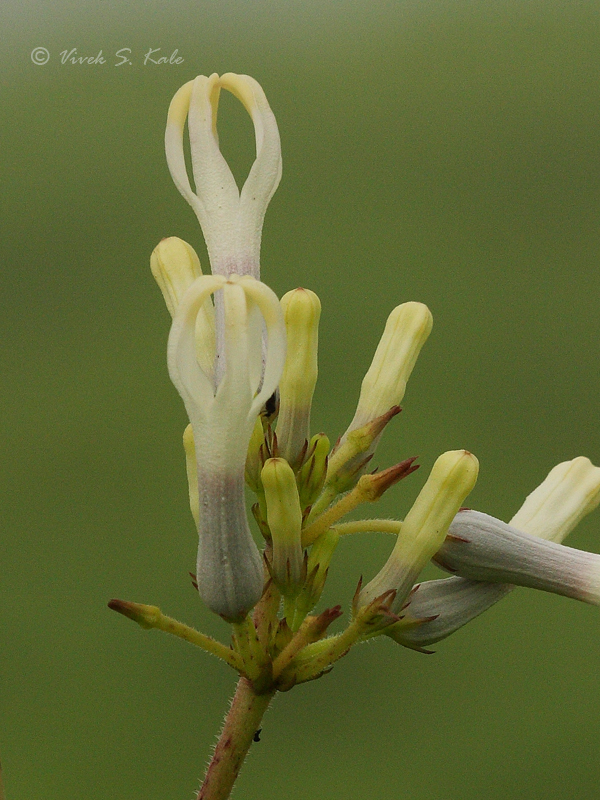 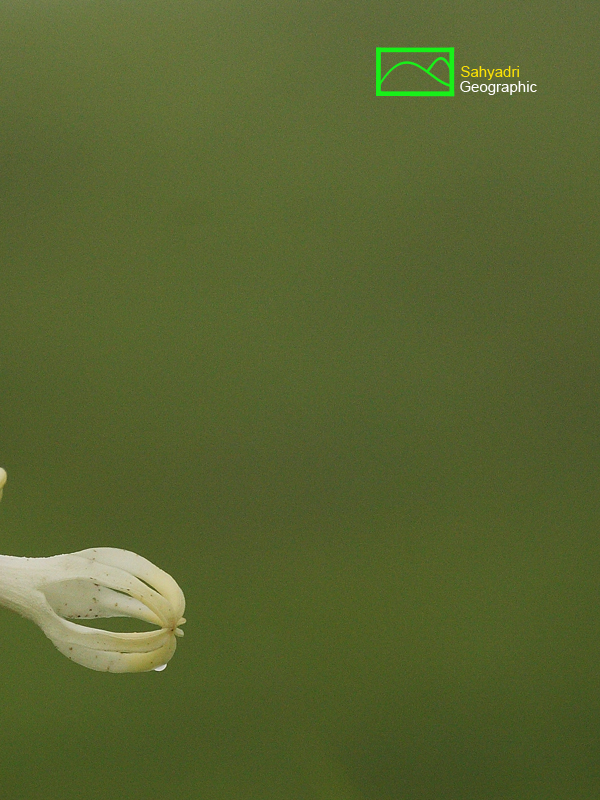 |
| |
| Ceropegia rollae, Chavand fort, Pune district, Western ghats, India
|
| |
|
|
खरपुडी (खर्चुडी) चा एक अत्यंत दुर्मिळ प्रकार नाणे घाटाच्या आसपास आढळतो. त्याला रोलाई खरपुडी असे म्हणतात. चावंड किल्यावर आढळलेली हि वनस्पती पावसाळ्यात फुलते. आय यु सी एन च्या अत्यंत दुर्मिळ झाडांच्या यादीत या वनस्पतीचा उल्लेख आहे.खर्चुडी आपल्या कंदिलपुष्पात लहान किटक व माश्यांना आमंत्रीत करते. माश्यांचा वापर करुन आपले परागीभवन करते. काम झाले की फुल गळुन पडते, व किटकाची फुलातुन सुटका होते. वनस्पती व किटक यांच्या मध्ये आढळणारे हे सामाजिक देवाणघेवाणीचे एक उदाहरण. आपल्याला यातुन बरेच काही शिकण्यासारखे आहे. खर्चुडीच्या बहुतेक जाती दुर्मीळ आहेत. सह्याद्रीत याच्या विविध जाती आढळतात. |
|
Ceropegia rollae is a rare plant seen in high altitude (900-1300) meters above msl, endemic to Pune/Ahmednagar districts. Only few hundred specimens exist in the wild. One of the plant in flowering season is shown in the photograph. These plants are very important from biodiversity point of view. Special care needs to be taken care of the endangered and endemic plants.
What is Ceropegia : (wikipedia)
The flowers have a tubular corolla with five petals most often fused at the tips, forming an umbrella-like canopy, a cage, or appendage-like antennae (Dyer, 1983). An interesting feature of Ceropegias is that their flower tubes are lined with small hairs that point downward to form a temporary trap for small flies. When flies are attracted into the flower by the odour they are prevented from escaping until the hairs wither, the pollinia of the Ceropegia flower being attached to the flies’ bodies when they escape.
|
|
|
| |
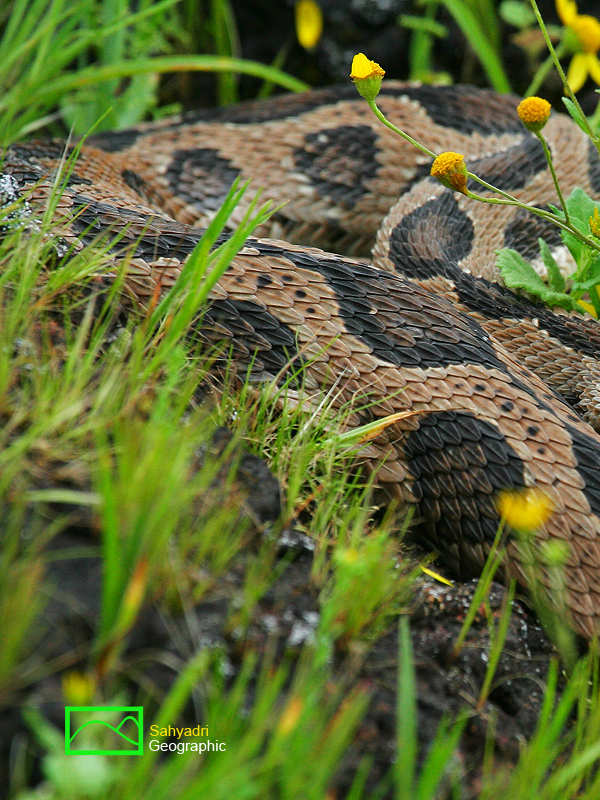 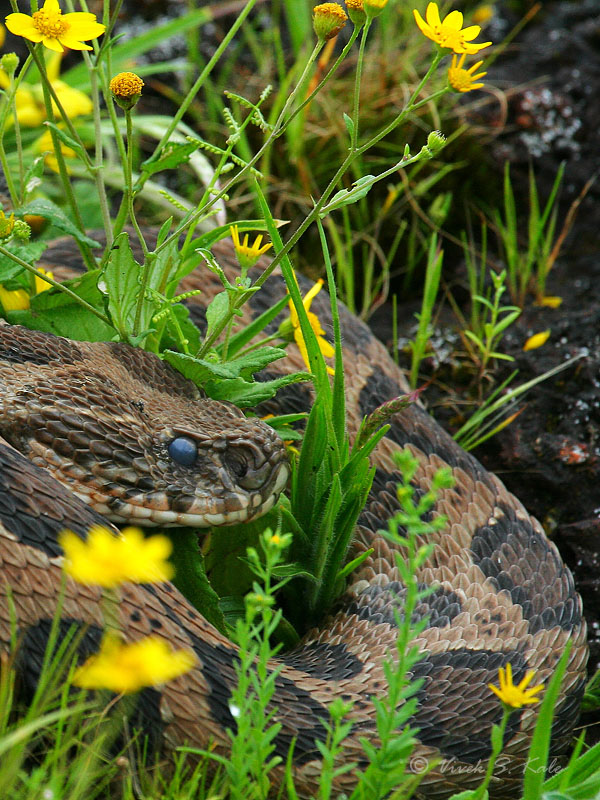 |
| |
| Russels viper, western ghats, India
|
| |
|
|
| |
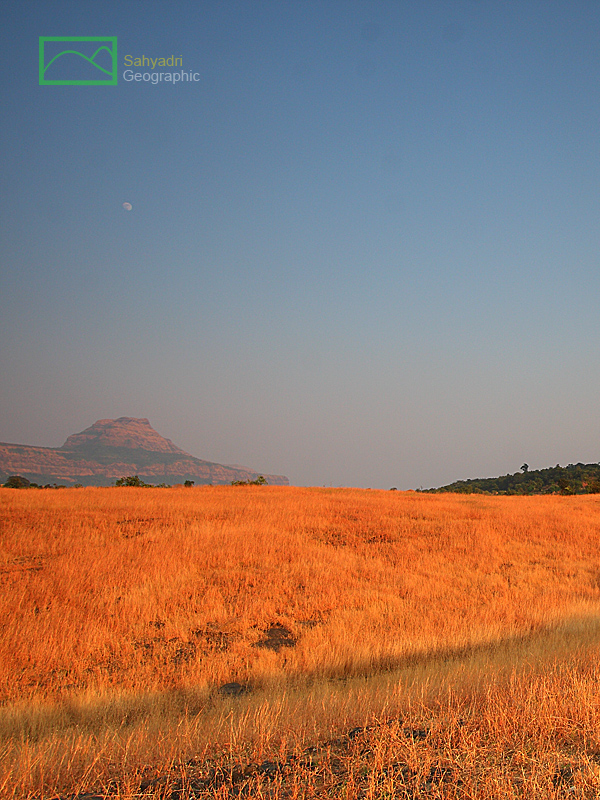 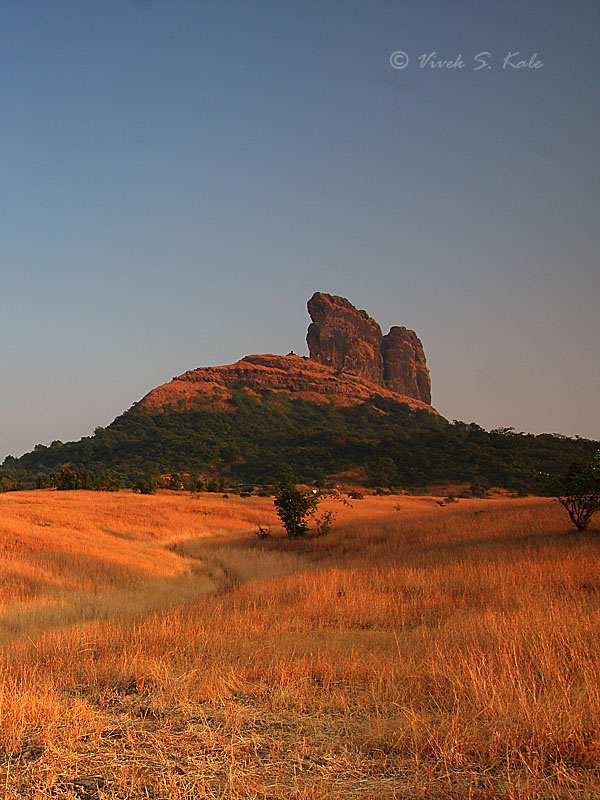 |
| |
| Grass in divine sunset light, Telbaila plateaue, Western ghats, India
|
| |
|
|
सुंदर सुर्यप्रकाशाने सांज वेळी, गवताने सजलेले रान सोनेरी झाले. वाऱ्याच्या हलक्या झुळुके संगत गवत झुलत होते. गवतावर लाटा वाहत होत्या. गवताच्या पात्यांची हलकी सळसळ ऐकु आली. सह्याद्रीच्या डोंगर माथ्यावर, नदयांच्या पात्रात, पठारांवरच्या माळरानी सर्वत्र गवत दिसते. पावसाळ्यात हिरवे तर इतर वेळी ते सोनेरी असते. शास्त्राप्रमाणे गवताने आपल्या गृहावर झालेल्या जीवसृष्टीच्या उत्पत्तीत, व माणसाच्या प्रगतीत मुख्य भुमिका पार पाडली आहे. माणसाने लावलेल्या शेतात, याच गवतावर गहु, भात पिकवला जातो. तर जंगलात निसर्गात गवताची पैदास पक्षी , प्राणी व किटक करतात. वाघाच्या पट्टेरी रुपाची प्रतिमा जणु वाऱ्याच्या झुळुकेसंग डोलणाऱ्या गवतात आहे. असे हे अप्रतिम गवत.
अनिरुद्ध धामोरीकर यांनी लिहिलेले हे गवताचे वर्णन स्वैर भाषांतर करुन मांडले आहे. त्याचे इग्रजी भाषेवरचे प्रभुत्व व निसर्गाबद्दल लिहिलेले लेख, "सह्याद्रीका" या त्यांच्या वेबसाईट ला भेट देऊन जरुर वाचा.
|
|
Annirudha Dhamorikar is one of the finest english writers I have seen when it comes to the articulation of thoughts and observations about nature and western ghats. Please read what he writes about the grass.
From the rolling plains to sharp precipices, and mountain tops to tumultuous rivers, grass is probably the only omnipresent entity, dancing to the music of its own rustling blades. Some scientists argue that grasses have shaped the evolution on our planet, and indeed have revolutionized our lives. Sahyadri’s rolling hills and table-top mountains are spread with a mosaic of lime-green paddies, the region’s staple food, and grasses untamed and wild, pollinated and, like humans, harvested by a number of animals. Indeed, it wouldn’t be wrong to say that the very tiger’s stripes are a reflection of the grass swaying in the wind.
- Annirudha Dhamorikar.
Please visit his website on Nature and Sahyadri
http://www.sahyadrica.com/
|
|
|
| |
  |
| |
| …
|
| |
|
|
| |
|

































